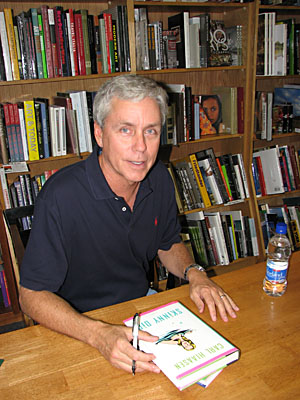[Read 12/17/2007] Science Fiction. 2005

River of Gods is a long book (~600 pages), and while it gets off to a slow start with many small chapters revealing a bunch of characters and plot lines, the book does take off about halfway through and then doesn’t let up. McDonald does manage to tie all the characters and plot lines together.
This huge tome has lots of ideas:
The book takes place in India of 2047. The level of sentience of AI’s is limited by law, and nothing higher than “2.5” is allowed. Any AI’s with higher levels of intelligence are tracked down by the Ministry and “excommunicated” (i.e. killed). A popular soap opera features CGI characters played by CGI actors. Medicine is so advanced that you can undergo surgery to become a genderless “nute”. Also, parents can have genetic engineering done to create a “Brahmin” child – which is disease free and lives >2x as long as normal. However, they physically mature more slowly, so you end up with an adult mind in a child-like body. Technology is advancing so that they can generate energy from the potential differences between two universes. Also, an alien artifact is found in space that is older than the solar system and holds a bunch of mysteries.
The Indian states of Bharat and Awadh are close to war because of a long drought. Indian culture and Hindi terms permeate the novel – sometimes making it hard to follow. I discovered the book actually had a glossary of Hindi terms; unfortunately this discovery was after I had finished the novel.
Cast of characters:
Shaheen Badoor Khan is the Bharat Prime Minister’s secretary. He’s an important person in the government (and has a predilection for nutes).
Tal is a nute and a set designer for the (CGI) soap opera “Town and Country”. He (it) is Khan’s desire…
Najia Askarzada is a reporter who interviews the soap (AI) characters and then gets involved in a big conspiracy.
Mr. Nandha is a Krisna cop with the Ministry. He hunts down roque AIs with the help of his own AIs. He’s so involved with his work that he doesn’t realize the budding affair between his wife and the gardener…
Vishram Ray inherits a large part of his father’s power company. The R+D division is working on harnessing the energy from the differences in ground states of different universes (wild!!). Turns out you get more power back than the power needed to open the “door” to the other universes.
Thomas Lull is an AI researcher (genius) who drops out of society and works on a beach. His skills are needed by Lisa D., a scientist who also happened to have had an affair with Lull. She and NASA need him to explore a large, 8-billion year old artifact found inside an asteroid.
Aj is a young girl who meets up with Lull. She’s mysterious not least because she seems to be able to control AIs and can read info about anyone/anything out of the air.
Shiv is a thug/murderer who is brought in by some big players to find something and is then manipulated.
All of these characters have separate plot lines until about halfway through the book – until then it’s hard to keep track of all of them, but the story does congeal. There’s lots of symbolism and imagery in the language of the novel and this makes for a rich read. It’s well worth the (moderate) effort.
Recommended!





